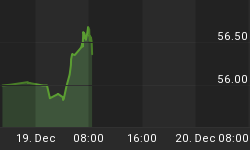I always like to say that it takes "bulls to make a bull market." These are the kinds of market conditions that would best characterize the strong bull runs that started in 1995, 1998, 2003 and 2009. In each of these time periods, the sentiment indicators became bullish very quickly off the bottom and stayed that way for months on end. As we end this week, higher prices have brought out the bulls as expected, and for the second week in a row, the "dumb money" indicator shows too many bulls. Surprisingly, the "smart money" indicator is also bullish at this juncture. There are lots of bulls and it is reasonable to wonder the following: are we entering a period where bullish sentiment will remain strongly bullish while the markets continue to move higher?
It is my belief that the bulk of the market gains seen in this rally are behind us, and there are 3 reasons why I believe this.
Reason #1. In the 4 time periods noted above, the markets were coming out of periods of severe under performance. In 1995, the markets were coming out of a 36 month consolidation, and in 1998, 2003, and 2009 the markets were deeply oversold following crushing losses. At this juncture, the current rebound appears to be nothing more than a mild, if not tenacious, oversold bounce. Prices were not too oversold prior to the start of the rally 8 weeks ago, and last year's gains were certainly respectable.
Reason #2. About 80% of the time when the "dumb money" indicator shows too many bulls, the next best buying opportunity will occur when this indicator show too many bears. In other words, the "dumb money" indicator will need to cycle lower, which means we should be seeing lower prices or a better buying opportunity in the future.
Reason #3. The April, 2010 ("flash crash") and November, 2007 ("market crash") highs are within several percentage points on the S&P500 and Nasdaq Composite, respectively. It would seem these milestones should provide some degree of resistance particularly for a rally built on such a tenuous foundation (i.e., poor volume).
In summary, the market trend remains up. Sentiment is becoming increasingly bullish. It is my belief that the best gains are behind us, and overbought conditions are expected to mean revert.
Now for this week's charts.
The "Dumb Money" indicator (see figure 1) looks for extremes in the data from 4 different groups of investors who historically have been wrong on the market: 1) Investors Intelligence; 2) Market Vane; 3) American Association of Individual Investors; and 4) the put call ratio. The "Dumb Money" indicator remains extremely bullish for the second week in a row. The current bounce has followed the expected script.
Figure 1. "Dumb Money"/ weekly
The "Smart Money" indicator is shown in figure 2. This is calculated utilizing data about SP100 options (or $OEX put call ratio), which is thought to represent large traders. The "smart money" is neutral. Previously, the "smart money" calculations utilized data from the NYSE; this data is no longer publicly available.
Figure 2. "Smart Money"/ weekly
Figure 3 is a weekly chart of the S&P500 with the InsiderScore "entire market" value in the lower panel. The value is neutral.
Figure 3. InsiderScore "Entire Market" Value/ weekly
Figure 4 is a weekly chart of the S&P500. The indicator in the lower panel measures all the assets in the Rydex bullish oriented equity funds divided by the sum of assets in the bullish oriented equity funds plus the assets in the bearish oriented equity funds. When the indicator is green, the value is low and there is fear in the market; this is where market bottoms are forged. When the indicator is red, there is complacency in the market. There are too many bulls and this is when market advances stall.
Currently, the value of the indicator is 54.56%. Values less than 50% are associated with market bottoms. Values greater than 58% are associated with market tops.
Figure 4. Rydex Total Bull v. Total Bear/ weekly
Improve your market timing with Premium Content from TheTechnicalTake.
The Premium Content service is the best $104 you will ever spend on market research. The daily report is meant to keep you on the right side of the market and improve your market timing. That's 40 cents a day!
Even in this confusing market environment, The Premium Content service has been useful in identifying trading opportunities. The indicators have functioned as expected!!!
To learn more about this service click here: Premium Content
To subscribe to Premium Content click here: Subscribe
















